fuel cap PONTIAC GRAND-AM 1995 Owners Manual
[x] Cancel search | Manufacturer: PONTIAC, Model Year: 1995, Model line: GRAND-AM, Model: PONTIAC GRAND-AM 1995Pages: 354, PDF Size: 17.81 MB
Page 123 of 354
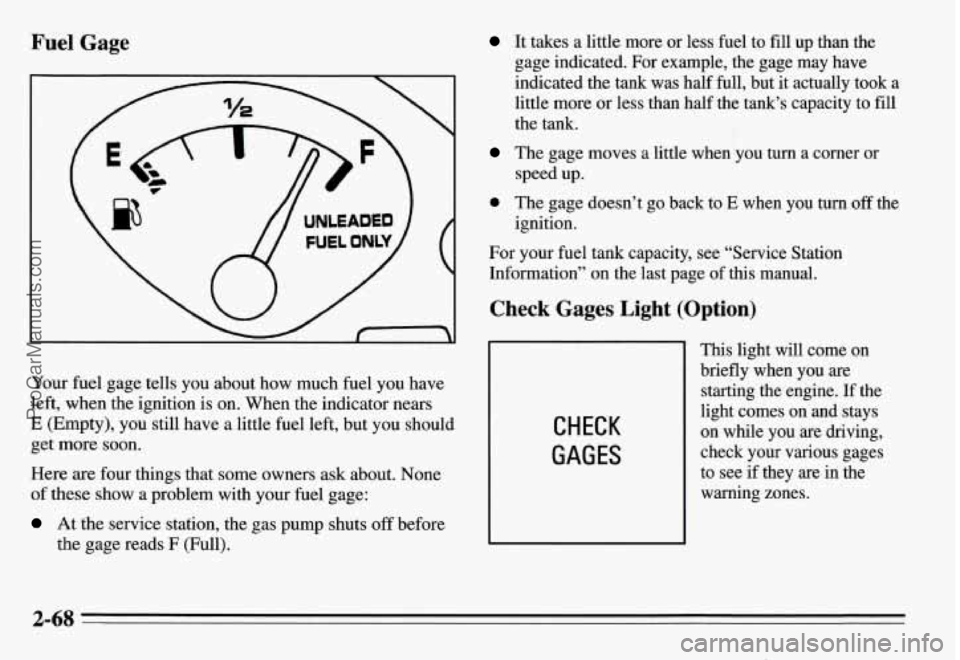
Fuel Gage
Your fuel gage tells you about how much fuel you have
left, when the ignition is on. When the indicator nears
E (Empty), you still have a little fuel left, but you should
get more soon.
Here are four things that some owners ask about. None
of these show a problem with your fuel gage:
At the service station, the gas pump shuts off before
the gage reads F (Full).
It takes a little more or less fuel to fill up than the
gage indicated. For example, the gage may have
indicated the tank was half full, but it actually took a
little more or less than half the tank’s capacity to fill
the tank.
The gage moves a little when you turn a corner or
0 The gage doesn’t go back to E when you turn off the
For your fuel tank capacity, see “Service Station
Information” on the last page of this manual.
Check Gages Light (Option)
speed up.
ignition.
CHECK
GAGES
This light will come on
briefly when you
are
starting the engine. If the
light comes on and stays
on while you are driving,
check your various gages
to see if they
are in the
warning zones.
2-68
ProCarManuals.com
Page 125 of 354
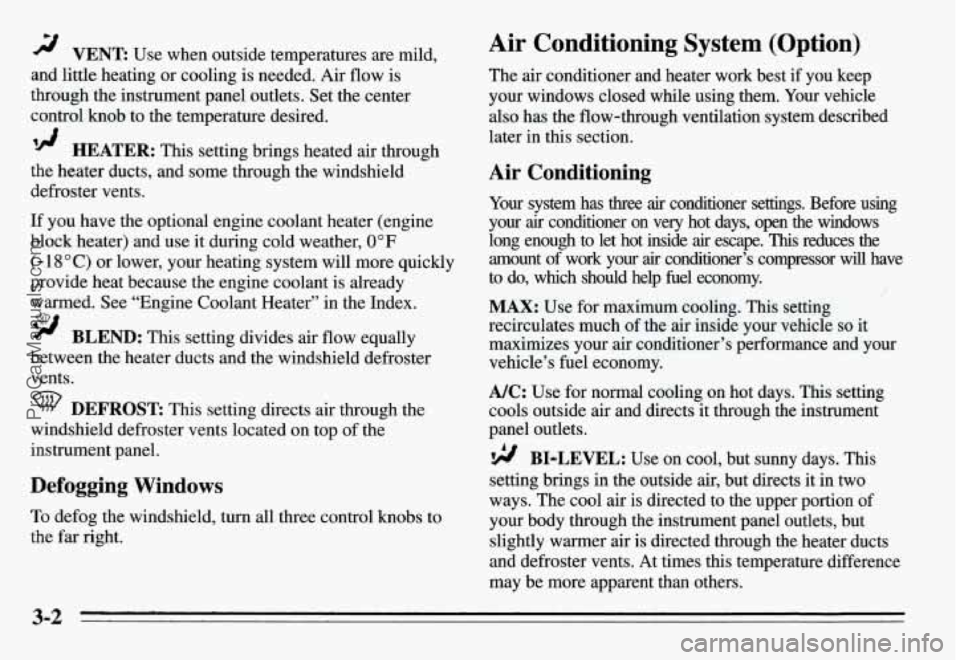
VENT Use when outside temperatures are mild,
and little heating or cooling is needed. Air flow is
through the instrument panel outlets. Set the center
control knob to the temperature desired.
HEATER: This setting brings heated air through
the heater ducts, and some through the windshield
defroster vents.
If you have the optional engine coolant heater (engine
block heater) and use it during cold weather,
0°F
(- 18 “C) or lower, your heating system will more quickly
provide heat because the engine coolant is already
warmed. See “Engine Coolant Heater” in the Index.
9 BLEND: This setting divides air flow equally
between the heater ducts and the windshield defroster
vents.
DEFROST This setting directs air through the
windshield defroster vents located on top of the
instrument panel.
Defogging Windows
To defog the windshield, turn all three control knobs to
the
far right.
Air Conditioning System (Option)
The air conditioner and heater work best if you keep
your windows closed while using them. Your vehicle
also has the flow-through ventilation system described
later in this section.
Air Conditioning
Your system has three air conditioner settings. Before using
your
air conditioner on very hot days, open the windows
long enough to let hot inside
air escape. This reduces the
amount
of work your air conditioner’s compressor will have
to do, which should help fuel economy.
MAX: Use for maximum cooling. This setting
recirculates much of the air inside your vehicle
so it
maximizes your air conditioner’s performance and your
vehicle’s fuel economy.
A/C: Use for normal cooling on hot days. This setting
cools outside air and directs it through the instrument
panel outlets.
BI-LEVEL: Use on cool, but sunny days. This
setting brings in the outside air, but directs it in two
ways. The cool air is directed to the upper portion
of
your body through the instrument panel outlets, but
slightly warmer air is directed through the heater ducts
and defroster vents. At times this temperature difference
may be more apparent than others.
ProCarManuals.com
Page 172 of 354
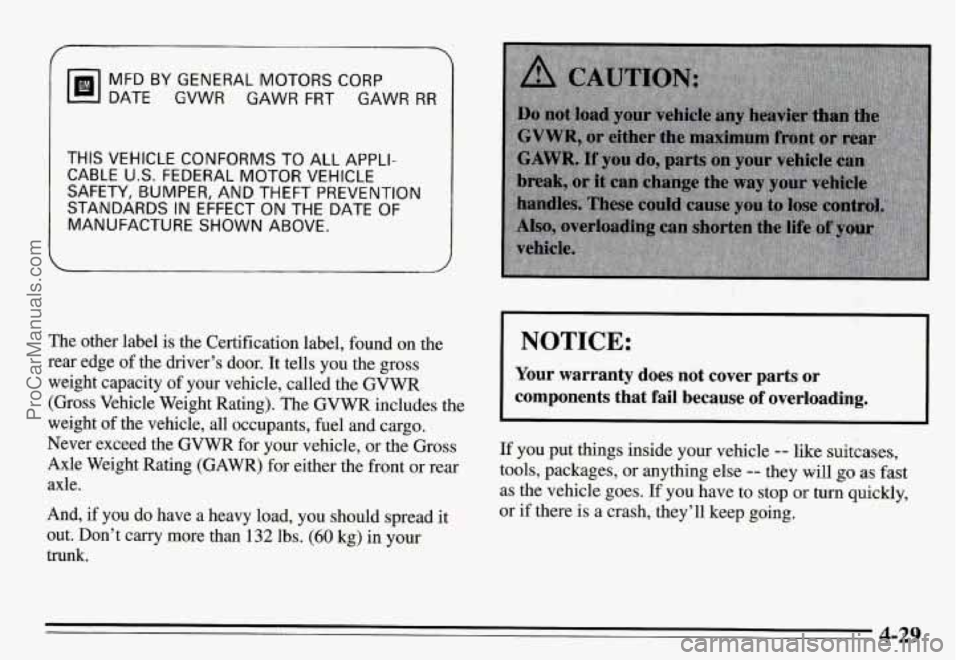
MFD BY GENERAL MOTORS CORP
DATE GVWR GAWR FRT GAWR RR
THIS VEHICLE CONFORMS TO ALL APPLI-
CABLE U.S. FEDERAL
MOTOR VEHICLE
SAFETY, BUMPER, AND THEFT PREVENTION
STANDARDS
IN EFFECT ON THE DATE OF
MANUFACTURE SHOWN ABOVE.
The other label is the Certification label, found on the
rear edge of the driver’s door. It tells you the gross
weight capacity
of your vehicle, called the GVWR
(Gross Vehicle Weight Rating). The GVWR includes the
weight of the vehicle, all occupants, fuel and
cargo.
Never exceed the GVWR for your vehicle, or the Gross
Axle Weight Rating (GAWR) for either the front
or rear
axle.
And, if you do have a heavy load, you should spread it
out. Don’t carry more than
132 lbs. (60 kg) in your
trunk.
NOTICE:
Your warranty does not cover parts or
components that fail because of overloading.
If you put things inside your vehicle -- like suitcases,
tools, packages, or anything else
-- they will go as fast
as the vehicle
goes. If you have to stop or turn quickly,
or if there is a crash, they’ll keep
going.
1
4-29
ProCarManuals.com
Page 174 of 354
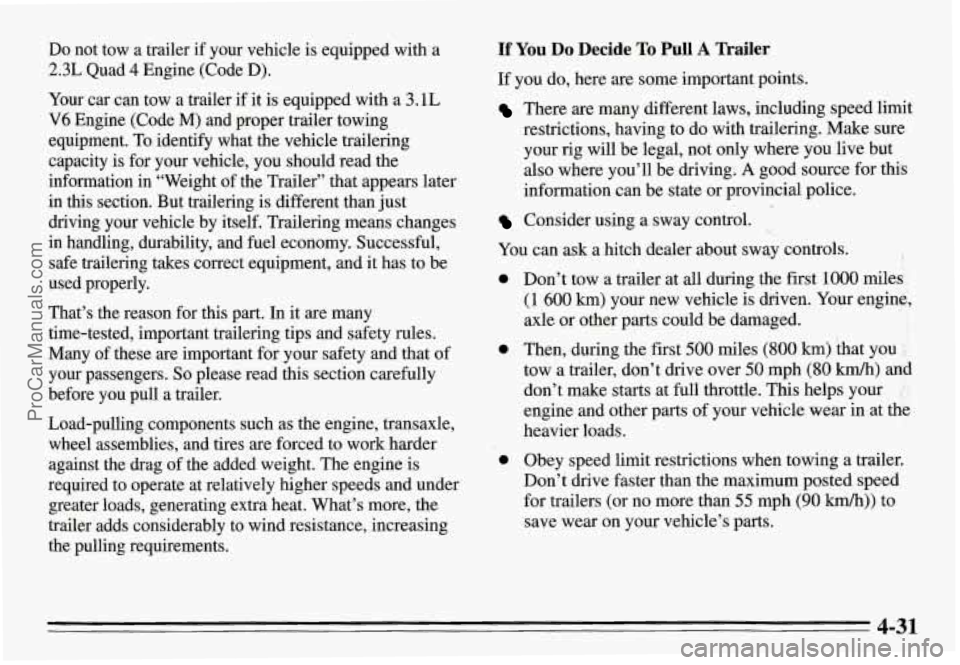
Do not tow a trailer if your vehicle is equipped with a
2.3L Quad 4 Engine (Code D).
Your car can tow a trailer if it is equipped with a 3.1L
V6 Engine (Code M) and proper trailer towing
equipment. To identify what the vehicle trailering
capacity is for your vehicle, you should read the
information in “Weight of the Trailer’’ that appears later
in this section. But trailering is different than just
driving your vehicle by itself. Trailering means changes
in handling, durability, and fuel economy. Successful,
safe trailering takes correct equipment, and it has to be
used properly.
That’s the reason for this part. In it are many
time-tested, important trailering tips and safety rules.
Many of these are important for your safety and that of
your passengers.
So please read this section carefully
before you pull a trailer.
Load-pulling components such as the engine, transaxle,
wheel assemblies, and tires are forced to work harder
against the drag of the added weight. The engine is
required to operate at relatively higher speeds and under
greater loads, generating extra heat. What’s more, the
trailer adds considerably to wind resistance, increasing
the pulling requirements.
If You Do Decide To Pull A Trailer
If you do, here are some important points.
There are many different laws, including speed limit
restrictions, having to do with trailering. Make sure
your rig will be legal, not only where you live but
also where you’ll be driving.
A good source for this
information can be state or provincial police.
Consider using a sway control.
You can ask a hitch dealer about sway controls.
e
e
e
Don’t tow a trailer at all during the first 1000 miles
(1 600 km) your new vehicle is driven. Your engine,
axle or other parts could be damaged.
Then, during the first 500 miles (800 km) that you
tow
a trailer, don’t drive over 50 mph (80 kmk) and
don’t make starts at full throttle.
This helps your
engine and other parts of your vehicle wear in at the
heavier loads.
Obey speed limit restrictions when towing a trailer.
Don’t drive faster
than the maximum posted speed
for trailers (or no more than
55 mph (90 km/h)) to
save wear on your vehicle’s parts.
4-31
ProCarManuals.com
Page 216 of 354
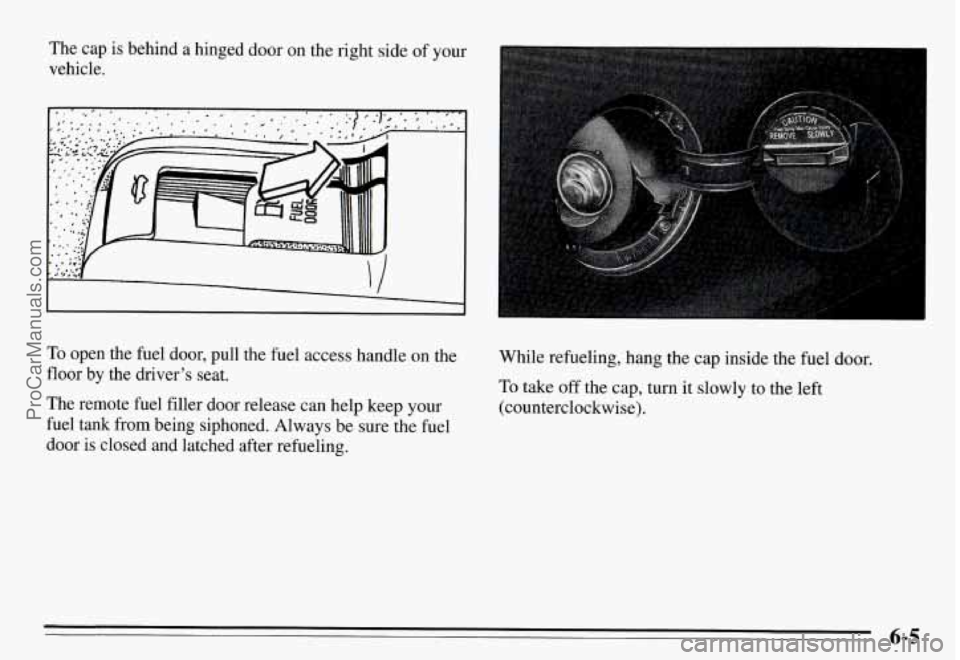
The cap is behind a hinged door on the right side of your
vehicle.
To open the fuel door, pull the fuel access handle on the
floor by the driver’s seat.
The remote fuel filler door release can help keep your
fuel tank from being siphoned. Always be sure the fuel
door is closed and latched after refueling.
While refueling, hang the cap inside the fuel door.
To take off the cap, turn it slowly to the left
(counterclockwise).
6-5
ProCarManuals.com
Page 217 of 354
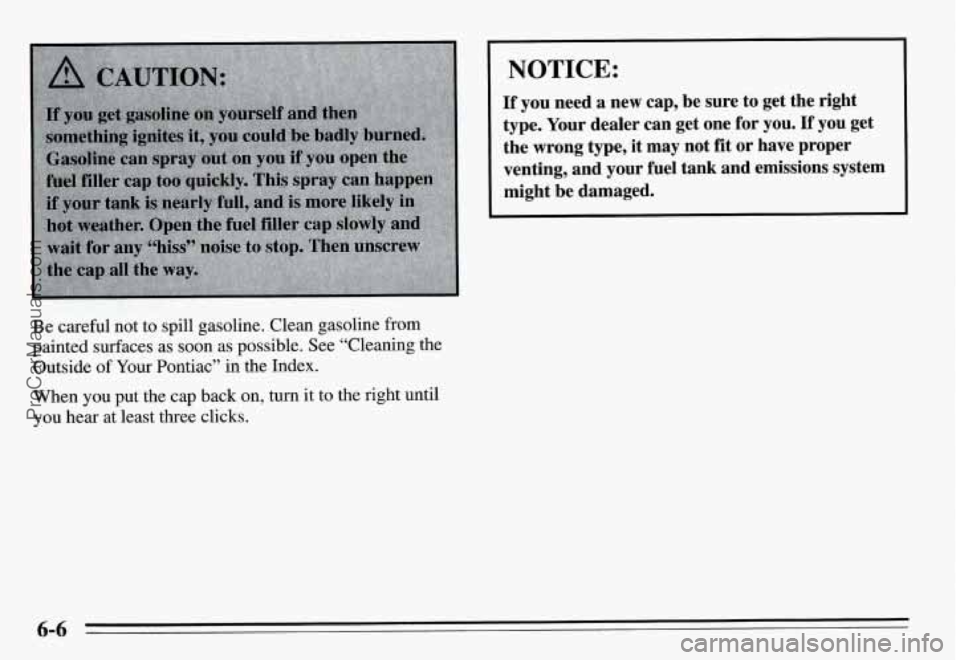
I NOTICE:
Be careful not to spill gasoline. Clean gasoline from
painted surfaces as soon as possible. See “Cleaning the
Outside
of Your Pontiac” in the Index.
When you put the cap back on, turn it to the right until
you hear at least three clicks.
If you need a new cap, be sure to get the right
type. Your dealer can get one for you.
If you get
the wrong type, it may not fit or have proper
venting, and your fuel tank and emissions system
might be damaged.
6-6
ProCarManuals.com
Page 247 of 354
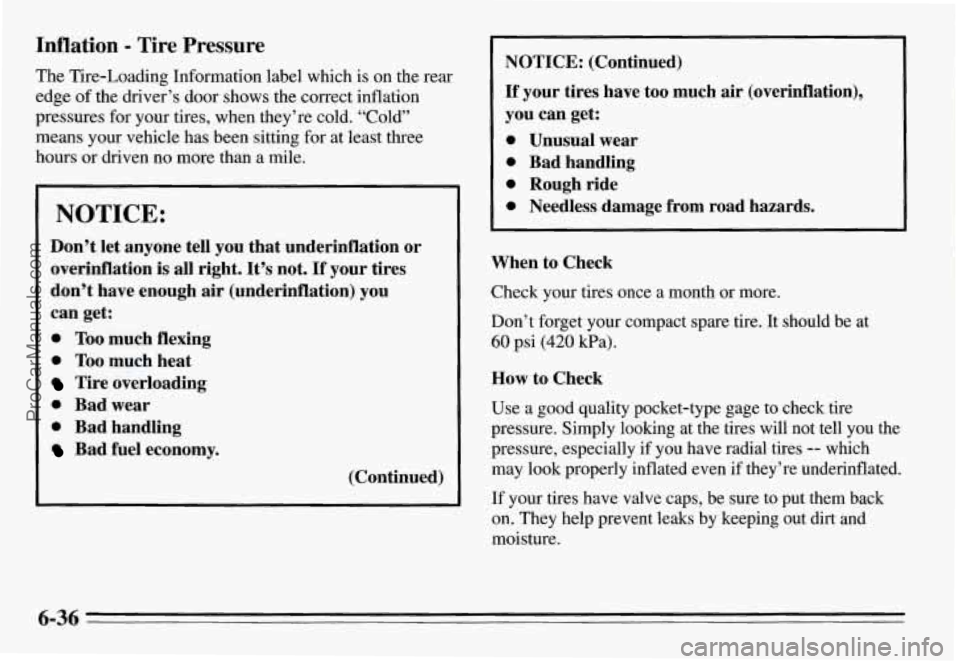
Inflation - Tire Pressure
The Tire-Loading Information label which is on the rear
edge of the driver’s door shows the correct inflation
pressures for your tires, when they’re cold. “Cold”
means your vehicle has been sitting for at least three
hours or driven no more than a mile.
I NOTICE:
Don’t let anyone tell you that underinflation or
overinflation
is all right. It’s not. If your tires
don’t have enough
air (underinflation) you
can get:
0 Too much flexing
0 Too much heat
Tire overloading
0 Bad wear
0 Bad handling
Bad fuel economy.
(Continued)
1 NOTICE: (Continued)
If your tires have too much air (overinflation),
you can get:
0 Unusual wear
0 Bad handling
0 Rough ride
0 Needless damage from road hazards.
When to Check
Check your tires once a month or more.
Don’t forget your compact spare tire. It should be at
60 psi (420 Wa).
How to Check
Use a good quality pocket-type gage to check tire
pressure. Simply looking at the tires will not tell you the
pressure, especially if you have radial tires
-- which
may look properly inflated even if they’re underinflated.
If your tires have valve caps, be sure to put them back
on. They help prevent leaks by keeping out dirt and
moisture.
6-36
ProCarManuals.com
Page 266 of 354
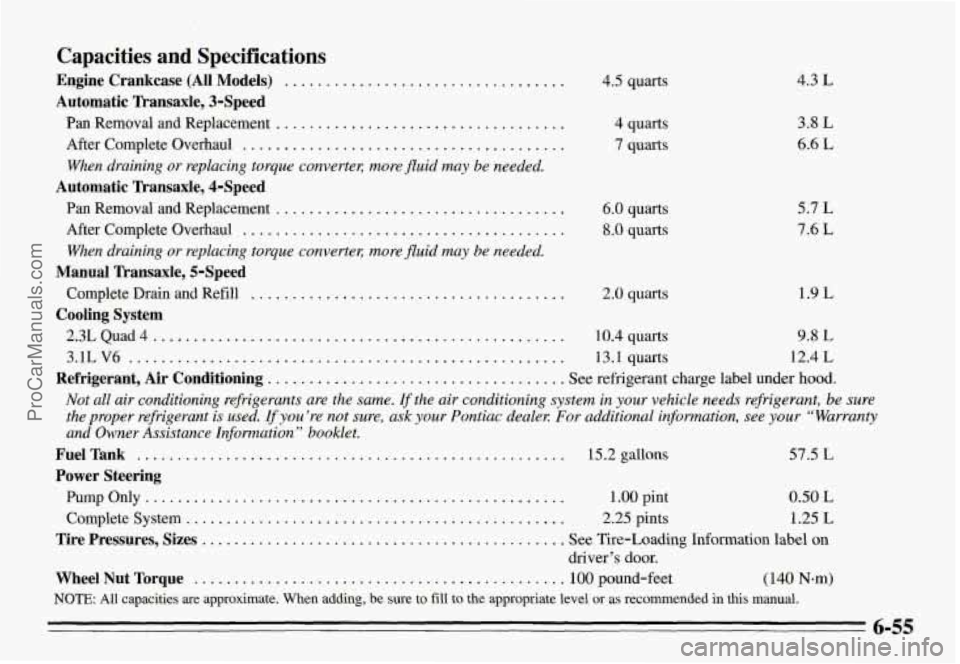
Capacities and Specifications
Engine Crankcase (All Models) ..................................
Automatic Transaxle, 3-Speed
Pan Removal and Replacement ...................................
When draining or replacing torque convertel; more fluid may be needed.
Pan Removal and Replacement ...................................
When draining or replacing torque convertel; more fluid may be needed.
After Complete Overhaul .......................................
Automatic Transaxle, 4-Speed
After Complete Overhaul .......................................
Manual Transaxle, 5-Speed
Cooling System
Complete Drain and Refill ......................................
2.3LQuad4 ..................................................
3.1LV6 .....................................................
4.5 quarts
4 quarts
7 quarts
6.0 quarts
8.0 quarts
2.0 quarts
4.3 L
3.8 L
6.6 L
5.7 L
7.6 L
1.9 L
10.4 quarts 9.8 L
13.1 quarts 12.4 L
Refrigerant, Air Conditioning .................................... See refrigerant charge label under hood.
Not all air conditioning refrigerants are the same. If the air conditioning system in your vehicle needs refrigerant, be sure
the proper refi-igerant is used.
If you’re not sure, ask your Pontiac dealel: For additional information, see your “Warranty
and Owner Assistance Information
” booklet.
FuelTank .................................................... 15.2gallons 57.5 L
Power Steering
Pumponly ................................................... 1.00 pint 0.50 L
Complete System .............................................. 2.25 pints 1.25 L
Tire Pressures, Sizes ............................................ See Tire-Loading Information label on
driver’s door.
WheelNutTorque ............................................. 100pound-feet (140 N-m)
NOTE: All capacities are approximate. When adding, be sure to fill to the appropriate level or as recommended in this manual.
6-55
ProCarManuals.com
Page 273 of 354
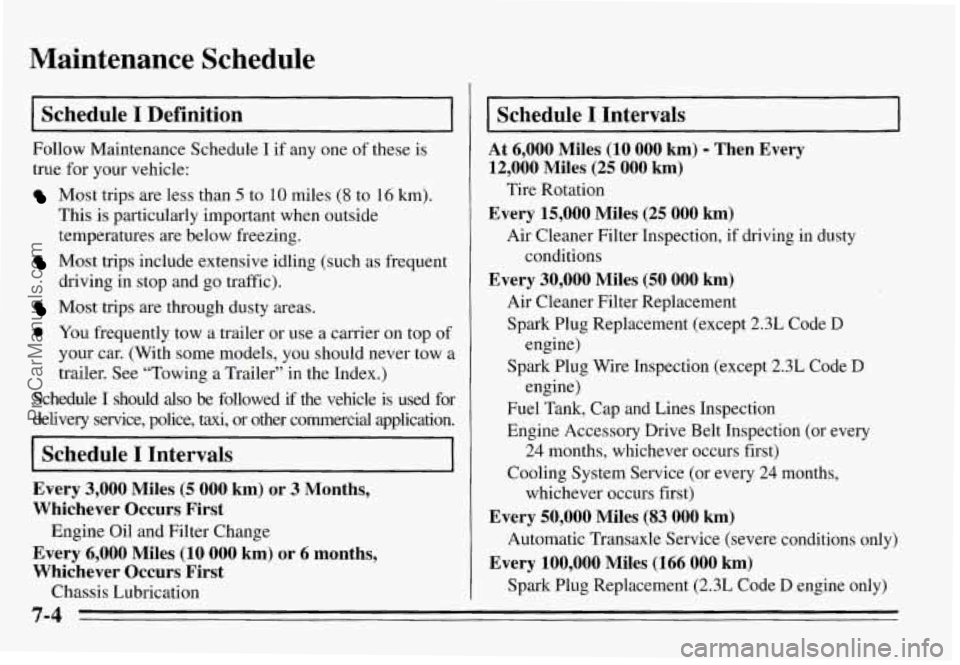
Maintenance Schedule
Schedule I Definition
Follow Maintenance Schedule I if any one of these is
true
for your vehicle:
Most trips are less than 5 to 10 miles (8 to 16 km).
This is particularly important when outside
temperatures are below freezing.
Most trips include extensive idling (such as frequent
driving in stop and go traffic).
Most trips are through dusty areas.
0 You frequently tow a trailer or use a carrier on top of
your car. (With some models, you should never tow a
trailer. See “Towing a Trailer” in the Index.)
S’chedule
I should also be followed if the vehicle is used for
delivery service, police,
taxi, or other commercial application.
Schedule I Intervals
Every 3,000 Miles (5 000 km) or 3 Months,
Whichever Occurs First
Every
6,000 Miles (10 000 km) or 6 months,
Whichever Occurs First
Chassis Lubrication
Engine Oil and Filter Change
Schedule I Intervals
At 6,000 Miles (10 000 km) - Then Every
12,000 Miles
(25 000 km)
Every 15,000 Miles (25
000 km)
Tire Rotation
Air Cleaner Filter Inspection, if driving in dusty
conditions
Every 30,000 Miles (50 000 km)
Air Cleaner Filter Replacement Spark Plug Replacement (except 2.3L Code
D
Spark Plug Wire Inspection (except 2.3L Code D
Fuel Tank, Cap and Lines Inspection
Engine Accessory Drive Belt Inspection (or every 24 months, whichever occurs first)
Cooling System Service (or every 24 months, whichever occurs first)
Every 50,000 Miles (83 000 km)
Every
100,000 Miles (166 000 km)
engine) engine)
Automatic Transaxle Service (severe conditions only)
Spark Plug Replacement (2.3L Code
D engine only)
7-4
ProCarManuals.com
Page 274 of 354
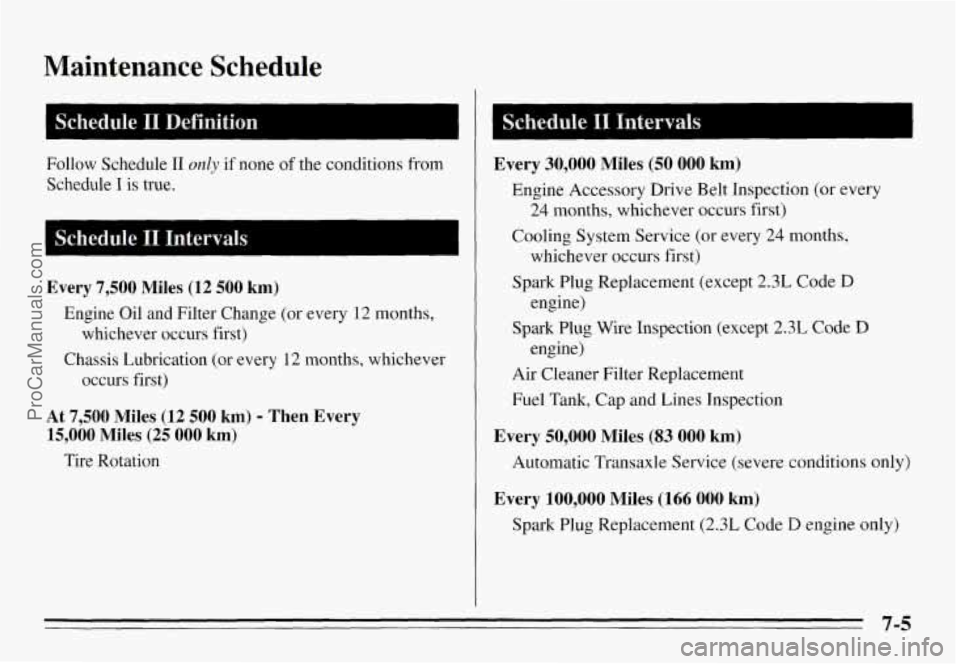
Maintenance Schedule
Schedule I1 Definition I
Follow Schedule I1 ordy if none of the conditions from
Schedule
T is true.
I Schedule I1 Intervals I
Every 7,500 Miles (12 500 km)
whichever occurs first)
occurs first)
Engine Oil and Filter Change (or every 12 months,
Chassis Lubrication (or every
12 months, whichever
At 7,500 Miles (12 500 km) - Then Every
15,000 Miles
(25 000 km)
Tire Rotation
Every 30,000 Miles (50 000 km)
Engine Accessory Drive Belt Inspection (or every
Cooling System Service (or every
24 months,
Spark Plug Replacement (except
2.3L Code D
Spark Plug Wire Inspection (except 2.3L Code D
Air Cleaner Filter Replacement
Fuel Tank, Cap and Lines Inspection
24 months, whichever occurs first)
whichever occurs first)
engine)
engine)
Every 50,000 Miles (83 000 km)
Automatic Transaxle Service (severe conditions only)
Every 100,000 Miles (166 000 km)
Spark Plug Replacement (2.3L Code D engine only)
7-5
ProCarManuals.com